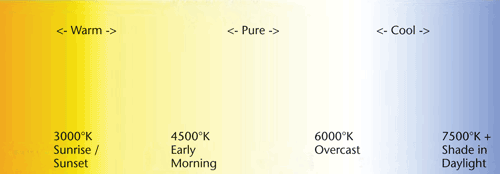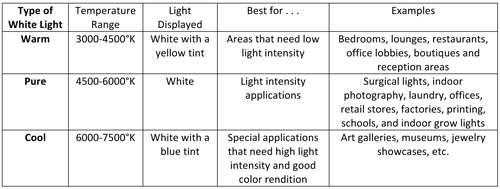A brief review on color temperature and how it affects white LED light
BY JEFFREY BAUSCH
While there are many variations of white LED light available today, they all fall under three basic categorical descriptions: “warm white,” “pure white,” and “cool white.” At opposite ends of the chart are “warm white,” which is a yellow tinted white light, and “cool white,” which displays a tint of blue. In between is “pure white” which, as the name suggests, is pretty much the most pure form white LED light available.
Only white and blue lights are measured in this sense; LEDs not in the white-blue spectrum do not.
Color temperature
In its most basic definition, color temperature is a standard of measurement in degrees Kelvin that is based on the physics concept of the “black body radiator”: it absorbs all the light/energy that impacts it, but according to thermodynamics, it’s also a perfect emitter.
A good example of this concept can be seen when a piece of metal is exposed to a heat source. The metal, in absorbing the heat, emits different colors as it warms up. It turns red when first heated, becomes orange as it gets hotter, turns white as the temperature continues to increase, and so on. You can actually determine an approximate temperature of the metal simply by recording the color it emits.
Despite the fact that LEDs produce light by a process other than heating, we still use correlated color temperature (CCT) when describing the appearance of the LED as it relates to the appearance of a black body radiator (in this example, that would be the piece of metal). The CCT, in this sense, is simply the closest point on the black body curve to a particular color as defined by its chromaticity value.
Different temperatures = different colors
When the glow of the white LED light is slightly yellow, it’s typically around 3000° Kelvin (K). Due to the yellowish tint of the light, this particular color is referred to as “warm white.” Further up the scale, “pure white” LED light measures at around 4500°K and even higher up is “cool blue” white light, which displays a reading of 6500°K or more.
Naturally, there’s some confusion over this. If the temperature is low, why is it considered “warm?” And if it’s high, why are we calling it “cool”?
You must consider the answer to this in the visual sense of how we’re using the words. The human mind has been conditioned for thousands and thousands of years to agree that the color yellow indicates warmth and blue means cool. As such, the words “warm” and “cool” are simply adjectives used to describe the type of color being emitted.
Examples
There are a ton of white light examples all around us that can be applied to the color temperature scale. The temperatures listed below are approximate (so save yourselves the hate letters, Kelvin enthusiasts):
White light at:
• Sunrise/Sunset: 2500°K
• Early afternoon sunlight: 5000°K
• Overcast sky: 6000°K
• Shade from blue sky: 7500°K
• Blue sky: 10,000°K +
Here’s how this translates visually:

Things to keep in mind when purchasing a white LED light
Higher color temperatures do not necessarily indicate a higher quality, or more expensive light. It also doesn’t mean that it’s any brighter than others. Variations in diodes largely affect the price of the products, not the LED’s color temperature range.
Also keep in mind that LEDs aren’t perfect. Every diode has a slight variation on their color temperature. Cheaper and less quality LEDs have a fairly wide color temperature range. For example, a warm white LED could range between 3000-3500°K. This is a pretty significant difference. High quality LEDs, on the other hand, have a somewhat tighter range, often times just 150°K difference.
Why is this important? Unexpected variations in white light could turn out to be quite noticeable depending upon how the LED is being used. Warm light is best used in living spaces as it tends to be more flattering to clothing and skin tones. Cool light, on the other hand, is preferred for visual tasks, as it produces excellent contrast. For best application practices, keep in mind these easy-to-remember basics:

Related Products: LEDs and LED Lighting
Advertisement
Learn more about Electronic Products Magazine





